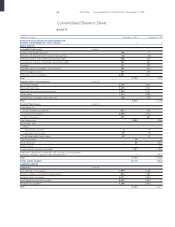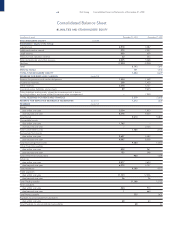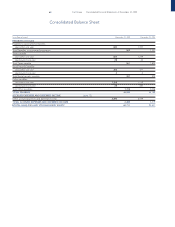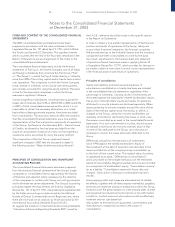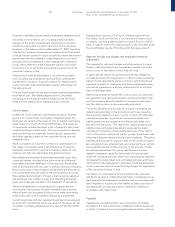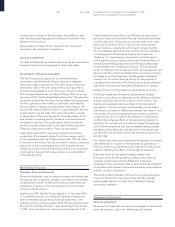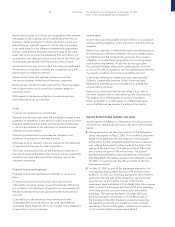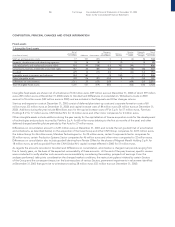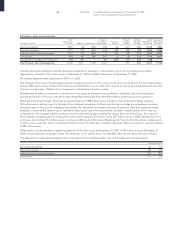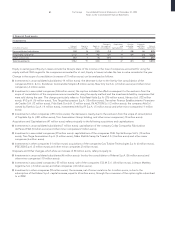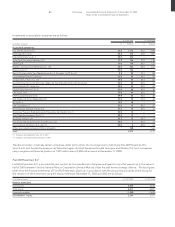Chrysler 2003 Annual Report Download - page 75
Download and view the complete annual report
Please find page 75 of the 2003 Chrysler annual report below. You can navigate through the pages in the report by either clicking on the pages listed below, or by using the keyword search tool below to find specific information within the annual report.
74 Fiat Group Consolidated Financial Statements at December 31, 2003
Notes to the Consolidated Financial Statements
The balance sheets of foreign subsidiaries are translated into
euros by applying the exchange rates in effect at year end. The
statements of operations of foreign subsidiaries are translated
using the average exchange rates for the year. In the financial
statements of subsidiaries operating in high-inflation countries
(cumulative inflation in excess of 100% in three years),
accounting principles for hyperinflationary economies are used.
Exchange differences resulting from the translation of opening
stockholders’ equity at current exchange rates and at the
exchange rates used at the end of the previous year, as well as
differences between net income expressed at average exchange
rates and expressed at current exchange rates, are reflected in
the stockholders’ equity caption “Cumulative translation
adjustments”.
The exchange rates used are summarized in Note 23.
OTHER INFORMATION
The following information is presented in the Report on
Operations:
❚Significant events occurring since the end of the fiscal
year and business outlook;
❚Transactions among Group Companies and with related
parties;
❚Statement of cash flows;
❚Transition to International Accounting Standards.
Accounting principles
Balance sheet
Fixed assets
Intangible fixed assets
Intangible assets and deferred charges expected to benefit
future periods are recorded at cost, adjusted by amortization
calculated on a straight-line basis over the period to be
benefited. In particular, goodwill and differences on
consolidation are amortized over a period of no more than
20 years, taking into account their expected period of recovery.
In general, the Group periodically reviews that the carrying value
of such assets is not higher than the estimated recovery value,
in relation to their use or realization, as determined by reference
to the most recent corporate plans. In cases in which there is a
permanent impairment in the estimated recovery value that is
lower than carrying value, appropriate writedowns are recorded.
The costs of researching and developing new products and/or
processes are mainly included in the results of operations in the
period in which such costs are incurred in line with the principle
of prudence and with international practice in the Automotive
industry.
Goodwill is recorded as an asset when acquired for
consideration.
Property, plant and equipment
Property, plant and equipment are recorded at purchase or
construction cost. These values are adjusted where specific laws
of the country in which the assets are located allow or require
revaluation, in order to reflect, even if only partially, changes
in the purchasing power of the currency. Cost also includes
financing expenses incurred during the construction period
for specific loans, where significant.
Depreciation is provided on a straight-line basis at rates that
reflect the estimated useful life of the related assets.
When, at the balance sheet date, property, plant and equipment
show a permanent impairment in value below their carrying
value, such assets are written down to the lower value,
according to the method indicated above for intangible assets.
Ordinary repairs and maintenance expenses related to property,
plant and equipment are charged to the statement of
operations in the year in which they are incurred, while
maintenance expenses which increase the value of property,
plant and equipment are capitalized and depreciated over
the estimated useful lives of the assets.
Capital investment grants related to investments in property,
plant and equipment are recorded as deferred income when
collection becomes certain and credited to income over the
useful life of the related asset.
Properties held by insurance companies to cover policy liabilities
and accruals are stated at acquisition cost and adjusted by the
compulsory law on revaluations imposed on Italian companies;
however, the carrying amounts do not exceed market value.
Depreciation is determined based on the useful life and
expected recovery value.
The revaluation of assets allowed by Law No. 342/2000, which
effected only a very few Italian companies of the Group, was
reversed in the consolidated financial statements, for purposes
of giving preference to the uniformity and comparability of the
accounting principles.
Financial fixed assets
Financial fixed assets include investments in unconsolidated
subsidiaries, associated companies and other companies,
financial receivables held for investment purposes, treasury
stock and other securities.
Investments in unconsolidated subsidiaries, in companies
in which Fiat exercises joint control with other partners and
in associated companies (those in which Fiat exercises, directly
or indirectly, a significant influence) are normally accounted for
using the equity method. This method is not used in cases in
which the investor no longer exercises significant influence over
the investee, in which case the cost is considered to be the
value of the investment taken from the prior year’s financial
statements.
Investments in other companies are valued at cost. In the event
of a permanent impairment in value, a specific allowance is
provided as a direct reduction of the asset account.




